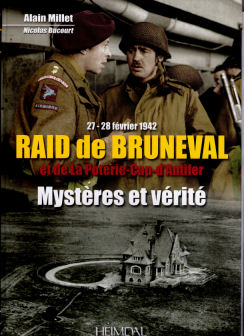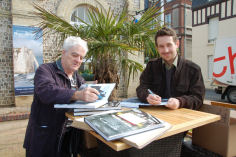|
Edith Elizabeth APPLETON O.B.E. R.R.C. This page last updated: 15 September 2012 |
RAID de BRUNEVAL – OPERATION BITING – 27-28 February 1942
Alain Millet, who gave me endless information and advice about Etretat
for Edie’s website, has published a most amazing book this year about
the WW2 Bruneval Raid which took place on 27-28 February 1942.
Alain is an expert on the subject and here is a picture of the
cover of his book.
During World War II, Operation Biting (also known as the
Bruneval Raid) was a successful Combined Operations raid to
capture components of a German Würzburg radar set at La
Poterie-Cap-d’Antifer and evacuated by the Bruneval beach on
27/28 February, 1942.
The book is packed with information and a huge number of
photographs of every aspect of the preparation and execution of
the famous raid.
< Click on image to enlarge

Alain tells me that the book is available from Casemate, W H Smith, Pick
a Book, Sprint Books, Blackwells, BookFellas, Amazon, and plenty more
outlets.
Here is a description of the book:
|
Alain Millet's book "The Bruneval Raid, La Poterie Cap
d’Antifer, Mystères and vérité” is written from thirty years of
research, interviews of many veterans of both sides, French
Resistants, local witnesses, archive papers and newspaper
articles from the period. It details "Operation Biting" (27/28
February 1942). Carried out by 120 paratroopers commanded by
Major Frost, this Raid allowed the British to steal a German
radar on the Normandy coast, North of Le Havre, with the
assistance of the RAF, the Navy and the Forces Françaises
Navales Libres in order to study it in England. Over 1000
pictures, in black and white and colour, illustrate the book.
Soon after the end of the Battle of Britain (November 1940) the
RAF wanted to regain the offensive over the Continent. However,
this quest increases its losses and threatens its survival. One
of the main causes: the radars that Germans are deploying in the
territories they occupied.
The book opens when a Signals unit of the Luftwaffe settled down
between Etretat and
The next part tells the story of the raid: the preparatory
intoxication operations that the RAF has carried out before zero
hour; the crossings of the Channel by plane or boat, the good or
bad parachute jumps around Bruneval. It surveys the attack and
the capture of the radar, the reactions of the enemy, the
breakthrough to the
The final part reveals the information that the allies have
drawn from the study of the Würzburg captured at Bruneval and
the jamming systems they developed accordingly. The allied
bombers can resume the offensive over the Continent with lower
losses. Certainly, in response, the Germans have modified their
defence organization. The book describes some of them, and the
huge radar position named Auerhahn that they build at the exact
site of the Raid in 1943. On June 5 and 6, 1944, using their
information found during "Operation Biting", the allies send
successful poisoning operations
against this base and other German defences’ of the
Channel and the North Sea coast. This proves that two years
later, the Bruneval Raid played a key role in the success of the |
Dick Robinson
15 September 2012
Read all about Etretat in World War One here: http://www.edithappleton.co.uk/Etretat/Alain_Millet.asp.

